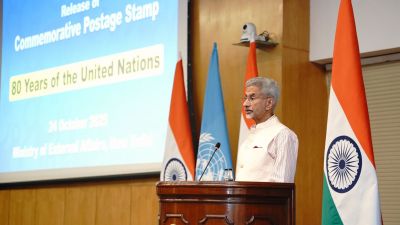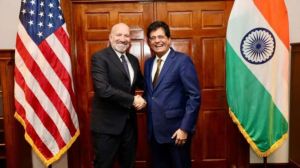The World is not Enough
Bangalore to Bangalore, via Kentucky...

Bangalore to Bangalore, via Kentucky
‘‘At that time, I was heading up the operations for GE Medical Systems in Bangalore. [GE’s chairman] Jack Welch came to India in 1989 and was completely taken by India as a source of intellectual advantage for GE. Jack would say, ‘India is a developing country with a developed intellectual capability.’ He saw a talent pool that could be leveraged. So he said, ‘We spend a lot of money doing software. Couldn’t we do some work for our IT department here?’ ’’
Because India had closed its market to foreign technology companies like IBM, Indian companies had started their own factories to make PCs and servers, and Welch felt that if they could do it for themselves, they could do it for GE.
To pursue the project, Welch sent a team headed by GE’s chief information officer over to India to check out the possibilities. Paul was also filling in as GE’s business development manager for India at the time. ‘‘So it was my job to escort the corporate CIO, in early 1990, on his first trip,’’ he recalled. ‘‘They had come with some pilot projects to get the ball rolling, I remember in the middle of the night going to pick them up at the Delhi airport with a caravan of Indian cars, Ambassadors …
‘‘So we had a five-car caravan and a we were driving back from the airport to town. I was in the back car, and at one point we heard this loud bang, and I thought, What happened? I shot to the front, and the lead car’s hood had flown off and smashed the windshield — with these GE people inside! So this whole caravan of GE execs pulls over to the side of the road, and I could just hear them saying to themselves, ‘This is is the place we’re going to get software from?’ ’’
 FORTUNATELY for India, the GE team was not discouraged by the poor quality of Indian cars. GE decided to sink roots, starting a joint development project with Wipro.
FORTUNATELY for India, the GE team was not discouraged by the poor quality of Indian cars. GE decided to sink roots, starting a joint development project with Wipro.
Other companies were trying different models. But this was still pre-fibre optic days. Simon & Schuster, the book publisher, for instance, would ship its books over to India and pay Indians $ 50 a month (compared to $ 1,000 a month in the United States) to type them by hand into computers, converting the books into digitised electronic files that could be edited or amended easily in the future — particularly dictionaries, which constantly need updating.
In 1991, Manmohan Singh, then India’s finance minister, began opening the Indian economy for foreign investment and introducing competition into the Indian telecom industry to bring down prices. To attract more foreign investment, Singh made it much easier for companies to set up satellite downlink stations in Bangalore, so they could skip over the Indian phone system and connect with their home bases in America, Europe, or Asia.
|
|
Before then, only Texas Instruments had been willing to brave the Indian bureaucracy, becoming the first multinational to establish a circuit design and development centre in India in 1985.
TI’s center in Bangalore had its own satellite downlink but had to suffer through having an Indian government official oversee it — with the right to examine any piece of data going in or out. Singh loosened all those reins post-1991.
A short time later, in 1994, HealthScribe India, a company originally funded in part by Indian-American doctors, was set up in Bangalore to do outsourced medical transcription for American doctors and hospitals. Those doctors at the time were taking handwritten notes and then dictating them into a Dictaphone for a secretary or someone else to transcribe, which would usually take days or weeks.
HealthScribe set up a system that turned a doctor’s touch-tone phone into a dictation machine. The doctor would punch in a number and simply dictate his notes to a PC with a voice card in it, which would digitise his voice. He could be sitting anywhere when he did it. Thanks to the satellite, a housewife or a student in Bangalore could go into a computer and download that doctor’s digitlised voice and transcribe it — not in two weeks but in two hours.
Then this person would zip it right back by satellite as a text file that could be put into the hospital’s computer system and become part of the billing file … (Ironically, said Gurujot Singh Khalsa, one of the founders of HealthScribe, they initially explored having Indians in Maine — that is, American Indians — do this work, using some of the federal money earmarked for the tribes to get started, but they could never get them interested enough to put the deal together).
The cost of doing the transcription in India was about one-fifth the cost per line of doing it the United States, a difference that got a lot of people’s attention.
BY the later 1990s, Lady Luck was starting to shine on India from two directions: the fibre-optic bubble was starting to inflate, linking India with the United States, and the Y2K computer crisis — the so-called millennium bug — started gathering on the horizon …
|
Story continues below this ad |
And so with Y2K bearing down on us, America and India started dating. ‘‘Y2K upgrading was tedious work that was not going to give them an enormous competitive advantage,’’ says Vivek Paul. ‘‘So all these western companies were incredibly challenged to find someone else who would do it and do it for as little money as possible. They said, ‘We just want to get past the damn year 2000!’ So they started to work with Indian [technology] companies who they might not have worked with otherwise.’’
To use my parlance, they were ready to go on a blind date with India. They were ready to get ‘‘fixed up.’’ Added Jerry Rao, chairman of MphasiS, ‘‘Y2K means different things to different people. For Indian industry, it represented the biggest opportunity. India was considered as a place of backward people. Y2K suddenly required that every single computer in the world needed to be reviewed. And the sheer number of people needed to review line-by-line code existed in India.
‘‘The Indian IT industry got its footprint across the globe because of Y2K. Y2K became our engine of growth, our engine of being known around the world. We never looked back after Y2K.’’
BY early 2000, the Y2K work started to wind down, but then a whole new driver of business emerged — e-commerce. The dotcom bubble had not yet burst, engineering talent was scarce, and demand from dotcoms was enormous.
Said Paul, ‘‘People wanted what they felt were mission-critical applications, key to their very existence, to be done and they could go nowhere else. So they turned to the Indian companies, and as they turned to the Indian companies they found that they were getting delivery of complex systems, with great quality, sometimes better than what they were getting from others. That created an enormous respect for Indian IT providers. And if [Y2K work] was the acquaintanceship process, this was the falling-in-love process.’’
Outsourcing from America to India, as a new form of collaboration, exploded. By just stringing a fibre-optic line from a workstation in Bangalore to my company’s mainframe, I could have Indian IT firms like Wipro, Infosys, and TCS managing my e-commerce and mainframe applications.
‘‘Once we’re in the mainframe business and once we’re in e-commerce — now we’re married,’’ said Paul. But again, India was lucky that it could exploit all that undersea fibre-optic cable. ‘‘I had an office very close to the Leela Palace hotel in Bangalore,’’ Paul added. ‘‘I was working with a factory located in the IT park in Whitefield, a suburb of Bangalore, and I could not get a local telephone line between our office and the factory. Unless you paid a bribe, you could not get a line, and we wouldn’t pay.
‘‘So my phone call to Whitefield would go from my office in Bangalore to Kentucky, where there was a GE mainframe computer we were working with, and then from Kentucky to Whitefield. We used our own fibre-optic lease line that ran across the ocean — but the one across town required a bribe.’’
Indiana outsources to India
In other words, an Indian consulting firm won the contract to upgrade the unemployment department of the state of Indiana! You couldn’t make this up. Indiana was outsourcing the very department that would cushion the people of Indiana from the effects of outsourcing.
Tata was planning to send some 65 contract employees to work in the Indiana Government Center, alongside 18 state workers. Tata also said it would hire local subcontractors and do some local recruiting, but most workers would come from India to do the computer overhauls, which, once completed, were ‘‘supposed to speed the processing of unemployment claims, as well as save postage and reduce hassles for business that pay unemployment taxes’’, the Indianapolis Star reported on June 25, 2004.
You can probably guess how the story ended. ‘‘Top aides to then-Gov. Frank O’Bannon had signed off on the politically sensitive four-year contract before his death (on) September 13 (2003),’’ the Star reported.
But when word of the contract was made public, Republicans made it a campaign issue. It became such a political hot potato that Governor Joe Kernan, a Democrat who had succeeded O’Bannon, ordered the state agency that helps out-of-work Indiana residents to cancel the contract — and also to put up legal barriers and frictions to prevent such a thing from happening again.
|
Story continues below this ad |
He also ordered that the contract be broken up into smaller bites Indiana firms could bid for — good for Indiana firms but very costly and inefficient for the state. The Indianapolis Star reported that a cheque for $ 993,587 was sent to pay off Tata for eight weeks of work, during which it had trained 45 programmers in the development and engineering of up-to-date software: ‘‘The company was great to work with,’’ said Alan Degenet, Indiana’s commissioner of workforce development.
SO now I have just one simple question. Who is the exploiter and who is the exploited in this India-Indiana story? The American arm of an Indian consulting firm proposes to save the taxpayers of Indiana $ 8.1 million by revamping their computers — using both its Indian employees and local hires from Indiana.
The deal would greatly benefit the American arm of the Indian consultancy; it would benefit some Indiana tech workers; and it would save Indiana state residents precious tax dollars that could be deployed to hire more state workers somewhere else, or build new schools. And yet the whole contract, which was signed by pro-labour Democrats, got torn up under pressure from free-trade Republicans.
Sort that out.
In the old world, where value was largely being created vertically, usually within a single company and from the top down, it was very easy to see who was on the top and who was at the bottom, who was exploiting and who was being exploited.
But when the world starts to flatten out and value increasingly gets created horizontally (through multiple forms of collaboration, in which individuals and little guys have much more power), who is exploiter and who is exploited gets very complicated. Some of our old political reflexes no longer apply.
WERE the Indian engineers not being ‘‘exploited’’ when their government educated them in some of the best technical institutes in the world inside India, but then that same Indian government pursued a socialist economic policy that could not provide those engineers with work in India …
Are those same engineers now being exploited when they join the biggest consultancy company in India, are paid a very comfortable wage in Indian terms, and, thanks to the flat world, can now apply their skills globally? Or are those Indian engineers now exploiting the people of Indiana by offering to revamp their state unemployment system for much less money than an American consulting firm? Or were the people of Indiana exploiting those cheaper Indian engineers? Someone please tell me.
Who is exploiting whom in this story? With whom does the traditional left stand in this story? With the knowledge workers from the developing world, being paid a decent wage, who are trying to use their hard-won talents in the developed world? Or with the politicians of Indiana, who wanted to deprive these Indian engineers of work so that it could be done, more expensively, by their constituents?
And with whom does all the traditional right stand in this story? With those who want to hold down taxes and shrink the state budget of Indiana by outsourcing some work, or with those who say, ‘‘Let’s raise taxes more in order to reserve the work here and reserve it just for people from Indiana?’’
If you are against globalisation because you think it harms people in developing countries, whose side are you on in this story: India’s or Indiana’s?
The Curse of Oil
They can use oil money to monopolise all the instruments of power — army, police and intelligence — and never have to introduce real transparency or power sharing. All they have to do is capture and hold the oil tap. They never have to tax their people, so the relationship between ruler and ruled is highly distorted. Without taxation, there is no representation. The rulers don’t really have to pay attention to the people or explain how they are spending their money — because they have not raised that money through taxes.
That is why countries focused on tapping their oil wells always have weak or nonexistent institutions. Countries focused on tapping their people have to focus on developing real institutions, property rights, rule of law, independent courts, modern education, foreign trade, foreign investment, freedom of thought, and scientific enquiry to get the most out of their men and women.
In an essay in Foreign Affairs called ‘‘Saving Iraq from its oil’’ (July-August 2004), development economists Nancy Birdsall and Arvind Subramanian point out that ‘‘34 less-developed countries now boast significant oil and natural gas resources that constitute at least 30 per cent of their total export revenue. Despite their riches, however, 12 of these countries’ annual per capita income remains below $ 1,500 … Moreover two-thirds of the 34 countries are not democratic, and of those that are, only three score in the top half of Freedom Houses’ world rankings of political freedom.’’
In other words, imagination is also a product of necessity — when the context you are living in simply does not allow you to indulge in certain escapist or radical fantasies, you don’t. Look where the most creative innovation is happening in the Arab-Muslim world today. It is in the places with little or no oil.
And which countries in that same region are paralysed or actually rolling back reforms? Saudi Arabia and Iran, which are awash in oil money. On December 9, 2004, at a time when crude oil prices had soared to near $ 50 a barrel, The Economist did a special report from Iran, in which it noted, ‘‘Without oil at its present sky-high price, Iran’s economy would be in wretched straits. Oil provides about half the government’s revenue and at least 80 per cent of export earnings. But, once again under the influence of zealots in parliament, the oil cash is being spent on boosting wasteful subsidies rather than on much-needed development and new technology.’’
It is worthy of note that Jordan began upgrading its education system and privatising, modernising, and deregulating its economy starting in 1989 — precisely when oil prices were way down and it could no longer rely on handouts from the Gulf oil states.
In 1999, when Jordan signed its free-trade agreement with the United States, its exports to America totalled $ 13 million. In 2004, Jordan exported over $ 1 billion of goods to America — things Jordanians made with their hands. The Jordanian governments has also installed computers and broadband Internet in every school.
Most important, in 2004, Jordan announced a reform of its education requirements for mosque prayer leaders. Traditionally, high school students in Jordan took an exam for college entrance, and those who did the best became doctors and engineers. Those who did the worst became mosque preachers.
In 2004, Jordan decided to gradually phase in a new system. Henceforth, to become a mosque prayer leader, a young man will first have to get a BA in some other subject, and can study Islamic law only as a graduate degree — in order to encourage more young men of talent to go into the clergy and weed out those who were just ‘‘failing’’ into it.
That is an important change in context that should pay dividends over time in the narratives that young Jordanians are nurtured upon in their mosques. ‘‘We had to go through a crisis to accept the need for reform,’’ said Jordan’s minister of planning, Bassem Awadallah.
ONLY when falling oil prices force the leaders in the Middle East to change their contexts will they reform. People don’t change when you tell them they should. They change when they tell themselves they must. Or as Johns Hopkins foreign affairs professor Michael Mandelbaum puts it, ‘‘People don’t change when you tell them there is a better option. They change when they conclude that they have no other option.’’
Give me $ 10-a-barrel oil and I will give you a political and economic reform from Moscow to Riyadh to Iran. If America and its allies will not collaborate in bringing down the price of crude oil, their aspirations for reform in all these areas will be stillborn.
There is another factor to consider here. When you have to make things with your hands and then trade with others in order to flourish, not just dig an oil well in your own backyard, it inevitably broadens imagination and increases tolerance and trust.
It is no accident that Muslim countries make up 20 per cent of the world’s population but account for only four per cent of world trade. When countries don’t make things anyone else wants, they trade less, and less trade means less exchange of ideas and openness to the world.
The most open, tolerant cities in the Muslim world today are its trading centres — Beirut, Istanbul, Jakarta, Dubai, Bahrain. The most open, tolerant cities in China are Hong Kong and Shanghai. The most closed cities in the world are in central Saudi Arabia, where no Christians, Hindus, Jews, or other non-Muslims are allowed to express their religions in public or build a house of worship, and, in the case of Mecca, even enter.
RELIGIONS are the smelters and founders of imagination. The more any religion’s imagination — Hindu, Christian, Jewish, Muslim, Buddhist — is shaped in an isolated bubble or in a dark cave, the more its imagination is likely to sail off in dangerous directions.
People who are connected to the world and exposed to different cultures and perspectives are far more likely to develop the imagination of 11/9 [November 11, 1989, when the Berlin Wall came down]. People who are feeling disconnected, for whom personal freedom and fulfilment are a utopian fantasy, are more likely to develop the imagination of 9/11.





- 01
- 02
- 03
- 04
- 05


























